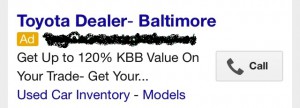Most PPC accounts are set up in a way that saves lots of time – but saving time isn’t your goal! This week’s Wednesday Workshop explains why the “every keyword in one ad group” strategy isn’t a great idea… and then explains why “micro ad groups” are the right way to set up your account. If your dealership does any PPC advertising, you don’t want to miss this video!
VIDEO TRANSCRIPT
Welcome back to the DealerOn Wednesday Workshop. Today we’re talking about paid search, also known as SEM or PPC.
And specifically we’re addressing campaign performance tips.
Since the beginning of automotive SEM campaigns, agencies and providers have employed Ad Group strategies that cram hundreds of keywords into each Ad Group, usually using dynamic keyword insertion. This is not optimal, but it is easy.
Typical automotive campaigns are set up this way to save time – it’s definitely not for optimal performance. You should avoid throwing every keyword into one ad group with a few generic ads. Sure, it saves time… but saving time isn’t your goal.
If you want to get the best results from your campaigns, use a micro ad group structure. With micro ad groups, there are only a few keywords in each ad group (both modified broad and exact match) that relate exactly to your text ad.
Space permitting, the ad should include the keywords in the headline, and the ad copy must speak to the keywords and land on a related page on your site. You should never have an ad land on your site’s home page. This will help your quality score and overall ad performance.
If you have questions about micro ad group structures or SEM in general, jump down to the comments section and leave your questions there. We’ll get back to you as soon as we can.
Thanks for check out this week’s video – See you next week with another DealerOn Wednesday workshop.




